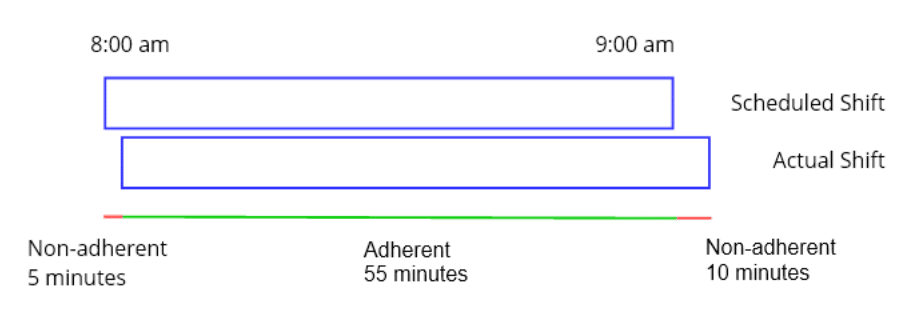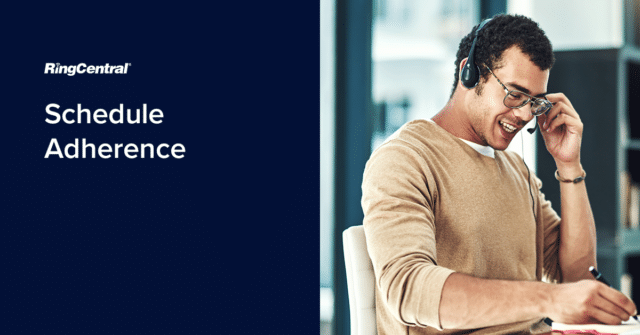Schedule adherence plays an important part in workforce planning and call centre performance. If the adherence rate is low, this could indicate a poor level of customer service.
What is schedule adherence?
Schedule adherence is a metric commonly used by call centres to indicate whether agents are adhering to their assigned schedules. Call centre adherence can take into account the time agents are on calls and activities related to a call they’ve just wrapped up, as well as scheduled breaks and agent activities, including meetings and training sessions.

Difference between schedule adherence and conformance
Broadly speaking, schedule adherence and conformance are measures of how well an agent is sticking to their schedule, and for that reason, they are both worth measuring. However, there are differences in an agent’s adherence and conformance.
We generally define schedule adherence as the amount of time an agent works, aligned with the time they were scheduled to work – i.e. how well they were aligned to their schedule.
Conformance measures the amount of time an agent worked compared to their schedule. In other words, “did the centre agent work the amount of time they were getting paid for?”.
Conformance looks at the total amount of time the agent actually works and divides that by the total amount of time they were scheduled to work, expressed as a percentage. Schedule adherence is more to do with whether the agent was working to the planned schedule.
Schedule adherence is also sometimes confused with ‘occupancy’. Occupancy is the time agents spend on call handling activities as a proportion of their total allocated time. Unlike adherence and conformance, this metric is usually only considered for a contact centre as a whole rather than for individual agents.
How does schedule adherence work?
The schedule adherence metric is measured by taking the total time within their scheduled work time that a call centre agent is available for calls and dividing it by that scheduled work time.
For example, in this case, a study from Callcentrehelper, an advisor is five minutes late for an hourly shift but then continues to work past the end of their scheduled shift by five minutes:

Since the formula for adherence is:
Adherence = (minutes in adherence/total schedule minutes) x 100
The adherence will be:
91.6% = (55/60) x 100
This data can be averaged with the adherence rates of all agents to give a figure for the entire contact centre. High adherence rates indicate that agents align with their schedules and offer customer service when they’re supposed to be.
When gauging adherence rates, call centres have to take into account factors outside the agent’s control. For example, calls that overrun into a break time. Each company has to decide the acceptable benchmark figures for adherence – 100% being obviously unattainable.
The impact of low adherence
Call centres put lots of effort into forecasting and scheduling, but this is wasted effort if agents don’t adhere to their schedules. Some centres mistakenly believe that it’s enough to know that agents are simply working their scheduled number of hours, even if they don’t align with the exact agent schedule.
While it’s the case that one agent being late by a few minutes will have little impact, there can be big consequences if the habit is more widespread. The average speed of answer (ASA) can be significantly reduced in a short period of time, thereby damaging the customer experience.
The value of measuring schedule adherence
Measuring schedule adherence is the first step required if improvements are to be made. Without the ability to measure adherence metrics, problems can remain unresolved.
Companies that measure how well agents are sticking to their schedules by running adherence reports gain important insights into improving workplace culture and productivity. Here are some chief benefits of measuring schedule adherence:
1. Increased workforce optimisation
By optimising schedule adherence, overall efficiency can be improved. Once a call centre knows exactly how many agents have the available time to help customers, they can hire the right staff. Individual efficiency can be measured via average handle time (AHT).
2. Increased fairness
By monitoring schedule adherence, centres can ensure all staff get the same amount of break time. This boosts productivity since agents will be neither over nor underworked nor taking too many breaks. It also means agents feel they are being treated more fairly, so they are less likely to become disgruntled.
3. Improvements to WFM (workforce management)
The workforce management market is gaining traction as businesses seek to optimise the efficiencies of their employees. Gaining the know-how of exactly how agents are spending their time helps centre managers plan things like staffing levels and how many agents are available to help customers at each time of day. This, thus, improves call flows and overall customer service.

Call centres can also manage large volumes of calls by using ACD (automatic call distribution), which automatically reroutes calls to available agents.
How to improve schedule adherence
There are several practical ways to improve centre schedule adherence and encourage better agent productivity.
1. Stress the importance of schedule adherence
Agents need to be taught the importance of schedule adherence from the ‘get go’, including during the onboarding process. This will ensure agents don’t fall into bad habits from the start.
2. Monitor statuses
Call centre technology can help to monitor how agents are actually spending their time. It can help managers identify workers who are setting their status to ‘busy’ when they aren’t spending time with customers.
3. Re-train agents
Give positive feedback to agents who are failing to stick to their schedules, and identify why this may be the case. Support them to overcome their challenges.
4. Reward productive agents
Offer incentives and rewards to agents who adhere to their schedules. This will not only keep top-performing staff motivated but set an example to others and encourage them to become more motivated.
5. Create a culture of teamwork
Emphasise how important it is for agents to respect each other’s time and that everyone needs to pull together to fulfil overall quotas.
RingCentral Contact Centre support
RingCentral offers a full technical support package for call centres, with software that offers real-time insights to help you boost adherence rates and achieve your target KPIs. With RingCentral technology, call centre agents can work anywhere yet still hit their service level goals with ease.
Head to our resource centre for in-depth information, including white papers and guides to help you identify the next steps to more effective call centre management.
Originally published May 17, 2021, updated Feb 14, 2024


